Application of Empirical Mode Decomposition for Decoding Perception of Faces Using Magnetoencephalography
Abstract
:1. Introduction
2. Materials and Methods
2.1. Dataset and Experimental Design
2.1.1. MEG Dataset of 16 Participants and Experimental Design
2.1.2. Simulation
2.2. Data Preprocessing
2.3. EMD Analysis
2.4. Neural Decoding
2.5. MEG Source Reconstruction
2.6. Region of Interest (ROI)
3. Results
3.1. Hilbert Spectra
3.2. dSPM
3.3. The Simulated Evoked Responses
3.4. Statistical Results
3.4.1. Whole Brain Activities
3.4.2. The ROIs
- Fusiform
- 2.
- Inferior Temporal
- 3.
- Entorhinal
- 4.
- Frontal
- 5.
- Medial Orbital Frontal
- 6.
- Temporal Pole
4. Discussion
5. Conclusions
Author Contributions
Funding
Institutional Review Board Statement
Informed Consent Statement
Data Availability Statement
Acknowledgments
Conflicts of Interest
References
- Klonowski, W. Everything You Wanted to Ask about EEG but Were Afraid to Get the Right Answer. Nonlinear Biomed. Phys. 2009, 3, 2. [Google Scholar] [CrossRef] [Green Version]
- Stallone, A.; Cicone, A.; Materassi, M. New Insights and Best Practices for the Successful Use of Empirical Mode Decomposition, Iterative Filtering and Derived Algorithms. Sci. Rep. 2020, 10, 15161. [Google Scholar] [CrossRef]
- Huang, N.E.; Shen, Z.; Long, S.R.; Wu, M.C.; Shih, H.H.; Zheng, Q.; Yen, N.-C.; Tung, C.C.; Liu, H.H. The Empirical Mode Decomposition and the Hilbert Spectrum for Nonlinear and Non-Stationary Time Series Analysis. Proc. R. Soc. London. Ser. A Math. Phys. Eng. Sci. 1998, 454, 903–995. [Google Scholar] [CrossRef]
- Nguyen, K.T.; Liang, W.-K.; Lee, V.; Chang, W.-S.; Muggleton, N.G.; Yeh, J.-R.; Huang, N.E.; Juan, C.-H. Unraveling Nonlinear Electrophysiologic Processes in the Human Visual System with Full Dimension Spectral Analysis. Sci. Rep. 2019, 9, 16919. [Google Scholar] [CrossRef]
- Wakeman, D.G.; Henson, R.N. A Multi-Subject, Multi-Modal Human Neuroimaging Dataset. Sci. Data 2015, 2, 150001. [Google Scholar] [CrossRef] [Green Version]
- Alink, A.; Abdulrahman, H.; Henson, R.N. Forward Models Demonstrate That Repetition Suppression Is Best Modelled by Local Neural Scaling. Nat. Commun. 2018, 9, 3854. [Google Scholar] [CrossRef] [Green Version]
- Quinn, A.J.; Vidaurre, D.; Abeysuriya, R.; Becker, R.; Nobre, A.C.; Woolrich, M.W. Task-Evoked Dynamic Network Analysis through Hidden Markov Modeling. Front. Neurosci. 2018, 12, 603. [Google Scholar] [CrossRef] [PubMed]
- Kia, S.M.; Vega Pons, S.; Weisz, N.; Passerini, A. Interpretability of Multivariate Brain Maps in Linear Brain Decoding: Definition, and Heuristic Quantification in Multivariate Analysis of MEG Time-Locked Effects. Front. Neurosci. 2017, 10, 619. [Google Scholar] [CrossRef] [PubMed] [Green Version]
- Bassez, I. Multivariate Statistics and Decoding for Electroencephalographic Data. Master’s Thesis, Ghent University, Ghent, Belgium, 19 June 2018. [Google Scholar]
- Wang, Y.; Huang, H.; Yang, H.; Xu, J.; Mo, S.; Lai, H.; Wu, T.; Zhang, J. Influence of EEG References on N170 Component in Human Facial Recognition. Front. Neurosci. 2019, 13, 705. [Google Scholar] [CrossRef] [PubMed] [Green Version]
- Takeda, Y.; Suzuki, K.; Kawato, M.; Yamashita, O. MEG Source Imaging and Group Analysis Using VBMEG. Front. Neurosci. 2019, 13, 241. [Google Scholar] [CrossRef]
- Soler, A.; Muñoz-Gutiérrez, P.A.; Bueno-López, M.; Giraldo, E.; Molinas, M. Low-Density EEG for Neural Activity Reconstruction Using Multivariate Empirical Mode Decomposition. Front. Neurosci. 2020, 14, 175. [Google Scholar] [CrossRef] [PubMed]
- Destrieux, C.; Fischl, B.; Dale, A.; Halgren, E. Automatic Parcellation of Human Cortical Gyri and Sulci Using Standard Anatomical Nomenclature. NeuroImage 2010, 53, 1–15. [Google Scholar] [CrossRef] [Green Version]
- Pedregosa, F.; Varoquaux, G.; Gramfort, A.; Michel, V.; Thirion, B.; Grisel, O.; Blondel, M.; Prettenhofer, P.; Weiss, R.; Dubourg, V.; et al. Scikit-learn: Machine learning in Python. J. Mach. Learn. Res. 2011, 12, 2825–2830. [Google Scholar]
- Gramfort, A.; Luessi, M.; Larson, E.; Engemann, D.A.; Strohmeier, D.; Brodbeck, C.; Goj, R.; Jas, M.; Brooks, T.; Parkkonen, L.; et al. MEG and EEG data analysis with MNE-Python. Front. Neurosci. 2013, 7, 267. [Google Scholar] [CrossRef] [PubMed] [Green Version]
- Fischl, B. FreeSurfer. Neuroimage 2012, 62, 774–781. [Google Scholar] [CrossRef] [Green Version]
- Dale, A.M.; Liu, A.K.; Fischl, B.R.; Buckner, R.L.; Belliveau, J.W.; Lewine, J.D.; Halgren, E. Dynamic Statistical Parametric Mapping. Neuron 2000, 26, 55–67. [Google Scholar] [CrossRef] [Green Version]
- Hung, C.P.; Kreiman, G.; Poggio, T.; DiCarlo, J.J. Fast Readout of Object Identity from Macaque Inferior Temporal Cortex. Science 2005, 310, 863–866. [Google Scholar] [CrossRef] [Green Version]
- Rapcsak, S.Z.; Nielsen, L.; Littrell, L.D.; Glisky, E.L.; Kaszniak, A.W.; Laguna, J.F. Face memory impairments in patients with frontal lobe damage. Neurology 2001, 57, 1168–1175. [Google Scholar] [CrossRef] [PubMed]
- Prabhakaran, V.; Narayanan, K.; Zhao, Z.; Gabrieli, J.D. Integration of Diverse Information in Working Memory within the Frontal Lobe. Nat. Neurosci. 2000, 3, 85–90. [Google Scholar] [CrossRef]
- Von Der Heide, R.J.; Skipper, L.M.; Olson, I.R. Anterior temporal face patches: A meta-analysis and empirical study. Front. Hum. Neurosci. 2013, 7, 17. [Google Scholar] [CrossRef] [Green Version]
- Bucolo, M.; Di Grazia, F.; Frasca, M.; Sapuppo, F.; Shannahoff-Khalsa, D. From Synchronization to Network Theory: A Strategy for Meg Data Analysis. In Proceedings of the 16th Mediterranean Conference on Control and Automation, Ajaccio, Corsica, France, 25–27 June 2008. [Google Scholar]
- Góngora, D.; Castro-Laguardia, A.M.; Pérez, J.; Valdés-Sosa, P.; Bobes, M.A. Anatomical Connections Underlying Personally-Familiar Face Processing. PLoS ONE 2019, 14, e0222087. [Google Scholar] [CrossRef] [PubMed] [Green Version]
- Kurth, S.; Moyse, E.; Bahri, M.A.; Salmon, E.; Bastin, C. Recognition of Personally Familiar Faces and Functional Connectivity in Alzheimer’s Disease. Cortex 2015, 67, 59–73. [Google Scholar] [CrossRef]
- Sharon, H.; Pasternak, Y.; Simon, E.B.; Gruberger, M.; Giladi, N.; Krimchanski, B.Z.; Hassin, D.; Hendler, T. Emotional Processing of Personally Familiar Faces in the Vegetative State. PLoS ONE 2013, 8, e74711. [Google Scholar] [CrossRef] [PubMed]
- Bucolo, M.; Rance, M.; Muscarello, A.; Spampinato, A.; Baeuchl, C.; Flor, H. Which Method Should Be Used for Brain Connectivity Analysis? In Proceedings of the 6th International IEEE/EMBS Conference on Neural Engineering (NER), San Diego, CA, USA, 6–8 November 2013. [Google Scholar]
- He, B.; Dai, Y.; Astolfi, L.; Babiloni, F.; Yuan, H.; Yang, L. EConnectome: A Matlab Toolbox for Mapping and Imaging of Brain Functional Connectivity. J. Neurosci. Methods 2011, 195, 261–269. [Google Scholar] [CrossRef] [PubMed] [Green Version]
- Shen, H.; Chau, D.K.; Su, J.; Zeng, L.-L.; Jiang, W.; He, J.; Fan, J.; Hu, D. Brain Responses to Facial Attractiveness Induced by Facial Proportions: Evidence from an FMRI Study. Sci. Rep. 2016, 6, 1–13. [Google Scholar] [CrossRef]
- Rudebeck, P.H.; Ripple, J.A.; Mitz, A.R.; Averbeck, B.B.; Murray, E.A. Amygdala Contributions to Stimulus–Reward Encoding in the Macaque Medial and Orbital Frontal Cortex during Learning. J. Neurosci. 2017, 37, 2186–2202. [Google Scholar] [CrossRef] [Green Version]
- O’Doherty, J.; Winston, J.; Critchley, H.; Perrett, D.; Burt, D.M.; Dolan, R.J. Beauty in a Smile: The Role of Medial Orbitofrontal Cortex in Facial Attractiveness. Neuropsychologia 2003, 41, 147–155. [Google Scholar] [CrossRef] [Green Version]
- Rhodes, G.; Proffitt, F.; Grady, J.M.; Sumich, A. Facial Symmetry and the Perception of Beauty. Psychon. Bull. Rev. 1998, 5, 659–669. [Google Scholar] [CrossRef] [Green Version]
- Little, A.C.; Jones, B.C. Evidence against Perceptual Bias Views for Symmetry Preferences in Human Faces. Proc. R. Soc. Lond. Ser. B Biol. Sci. 2003, 270, 1759–1763. [Google Scholar] [CrossRef] [Green Version]
- Thomas, C.; Avidan, G.; Humphreys, K.; Jung, K.; Gao, F.; Behrmann, M. Reduced structural connectivity in ventral visual cortex in congenital prosopagnosia. Nat. Neurosci. 2009, 12, 29–31. [Google Scholar] [CrossRef]
- Yovel, G.; Tambini, A.; Brandman, T. The asymmetry of the fusiform face area is a stable individual characteristic that underlies the left-visual-field superiority for faces. Neuropsychologia 2008, 46, 3061–3068. [Google Scholar] [CrossRef]
- De Renzi, E.; Perani, D.; Carlesimo, G.A.; Silveri, M.C.; Fazio, F. Prosopagnosia can be associated with damage confined to the right hemisphere—An MRI and PET study and a review of the literature. Neuropsychologia 1994, 32, 893–902. [Google Scholar] [CrossRef]
- Gazzaniga, M.S.; Smylie, C.S. Facial recognition and brain asymmetries: Clues to underlying mechanisms. Ann. Neurol. 1983, 13, 536–540. [Google Scholar] [CrossRef]
- Júnior, R.D.M.; de Sousa, B.M.; Fukusima, S. Hemispheric specialization in face recognition: From spatial frequencies to holistic/analytic cognitive processing. Psychol. Neurosci. 2014, 7, 503–511. [Google Scholar] [CrossRef]
- Harris, R.J.; Rice, G.E.; Young, A.W.; Andrews, T.J. Distinct but Overlapping Patterns of Response to Words and Faces in the Fusiform Gyrus. Cereb. Cortex 2015, 26, 3161–3168. [Google Scholar] [CrossRef] [Green Version]
- Bi, T.; Chen, J.; Zhou, T.; He, Y.; Fang, F. Function and Structure of Human Left Fusiform Cortex Are Closely Associated with Perceptual Learning of Faces. Curr. Biol. 2014, 24, 222–227. [Google Scholar] [CrossRef] [Green Version]
- Rossion, B.; Gauthier, I.; Goffaux, V.; Tarr, M.J.; Crommelinck, M. Expertise Training with Novel Objects Leads to Left-Lateralized Facelike Electrophysiological Responses. Psychol. Sci. 2002, 13, 250–257. [Google Scholar] [CrossRef] [PubMed]
- Kozunov, V.; Nikolaeva, A.; Stroganova, T.A. Categorization for Faces and Tools—Two Classes of Objects Shaped by Different Experience—Differs in Processing Timing, Brain Areas Involved, and Repetition Effects. Front. Hum. Neurosci. 2018, 11, 650. [Google Scholar] [CrossRef] [PubMed] [Green Version]
- Al-Subari, K.; Al-Baddai, S.; Tomé, A.M.; Volberg, G.; Ludwig, B.; Lang, E.W. Combined Emd-Sloreta Analysis of Eeg Data Collected during a Contour Integration Task. PLoS ONE 2016, 11, e0167957. [Google Scholar]
- Hansen, S.T.; Hemakom, A.; Safeldt, M.G.; Krohne, L.K.; Madsen, K.H.; Siebner, H.R.; Mandic, D.P.; Hansen, L.K. Unmixing Oscillatory Brain Activity by Eeg Source Localization and Empirical MODE Decomposition. Comput. Intell. Neurosci. 2019, 2019, 5618303. [Google Scholar] [CrossRef]
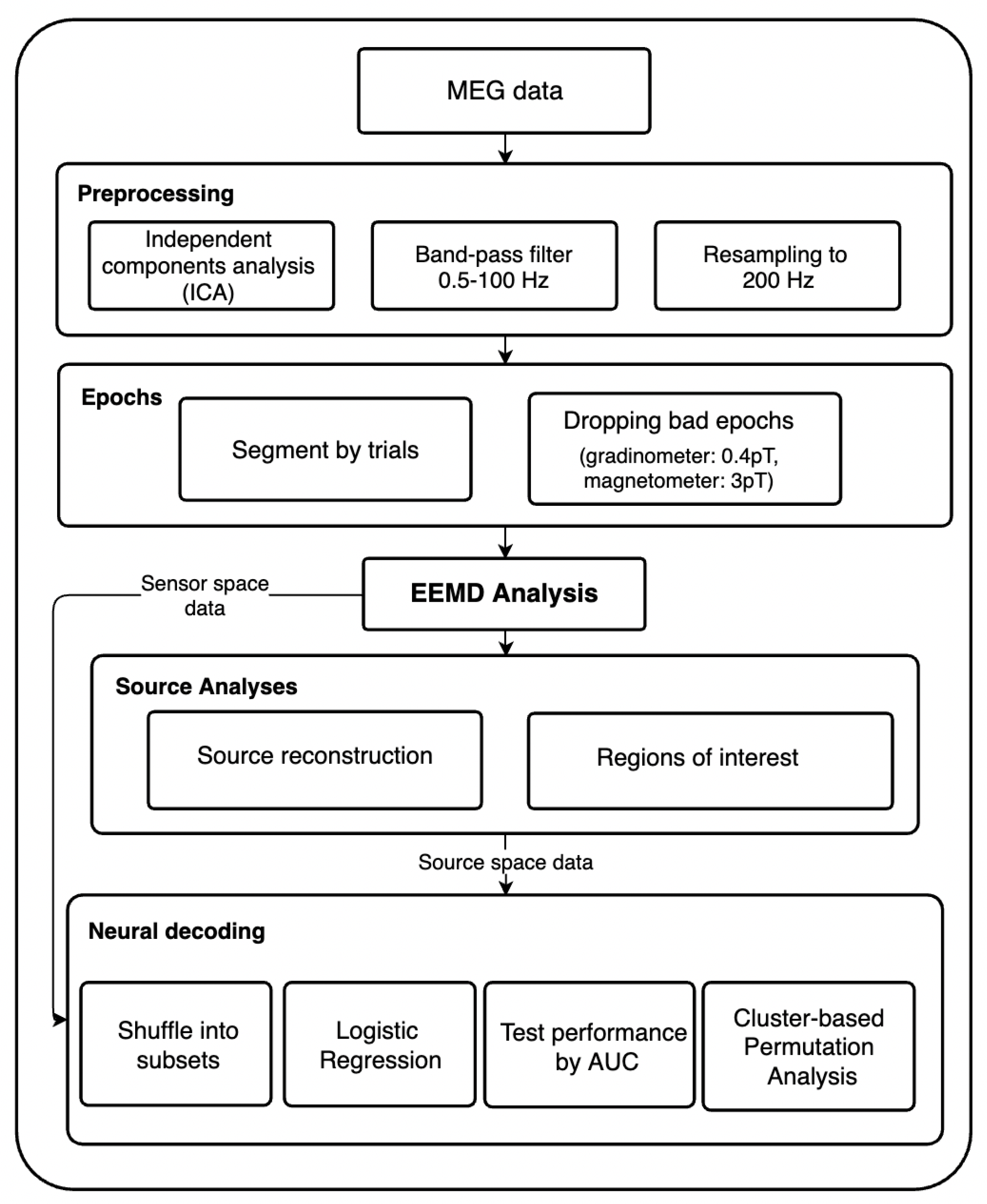
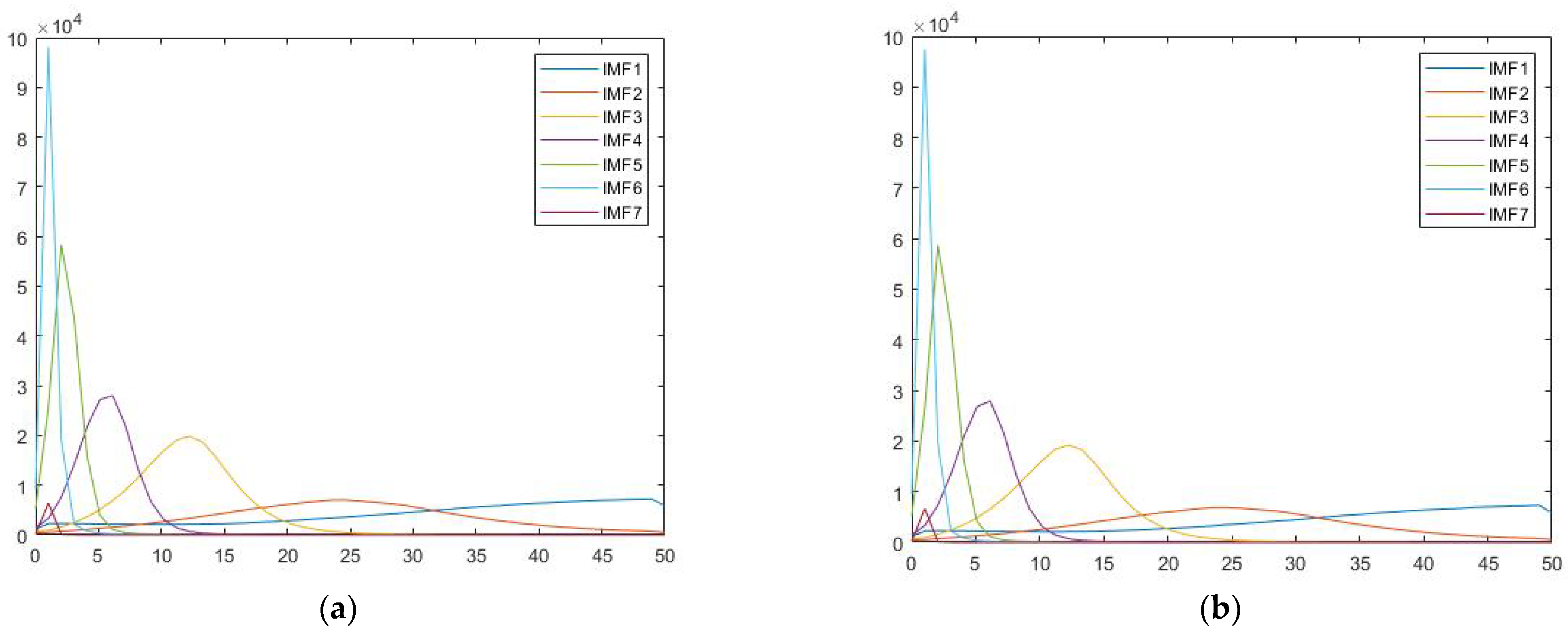
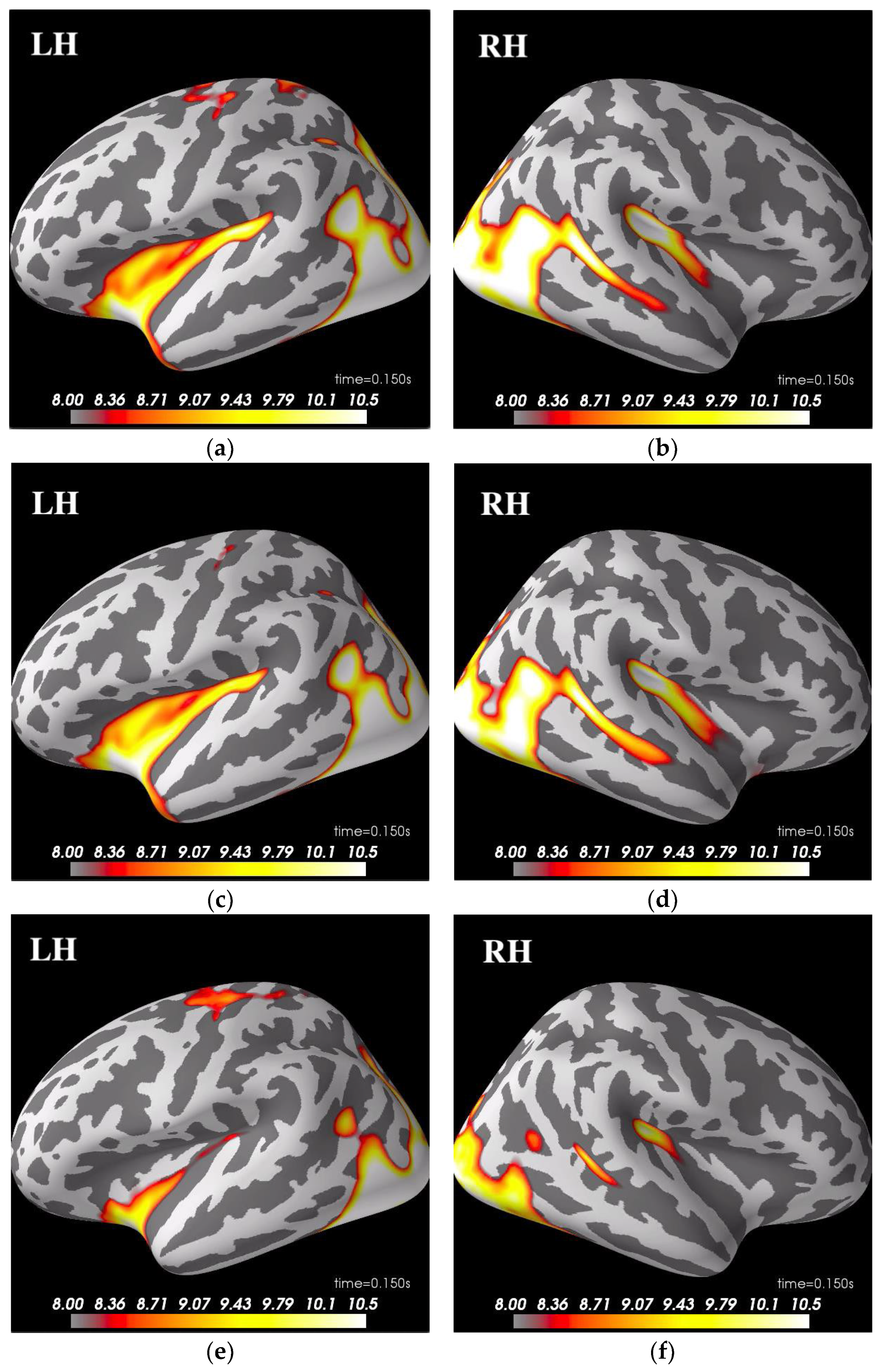
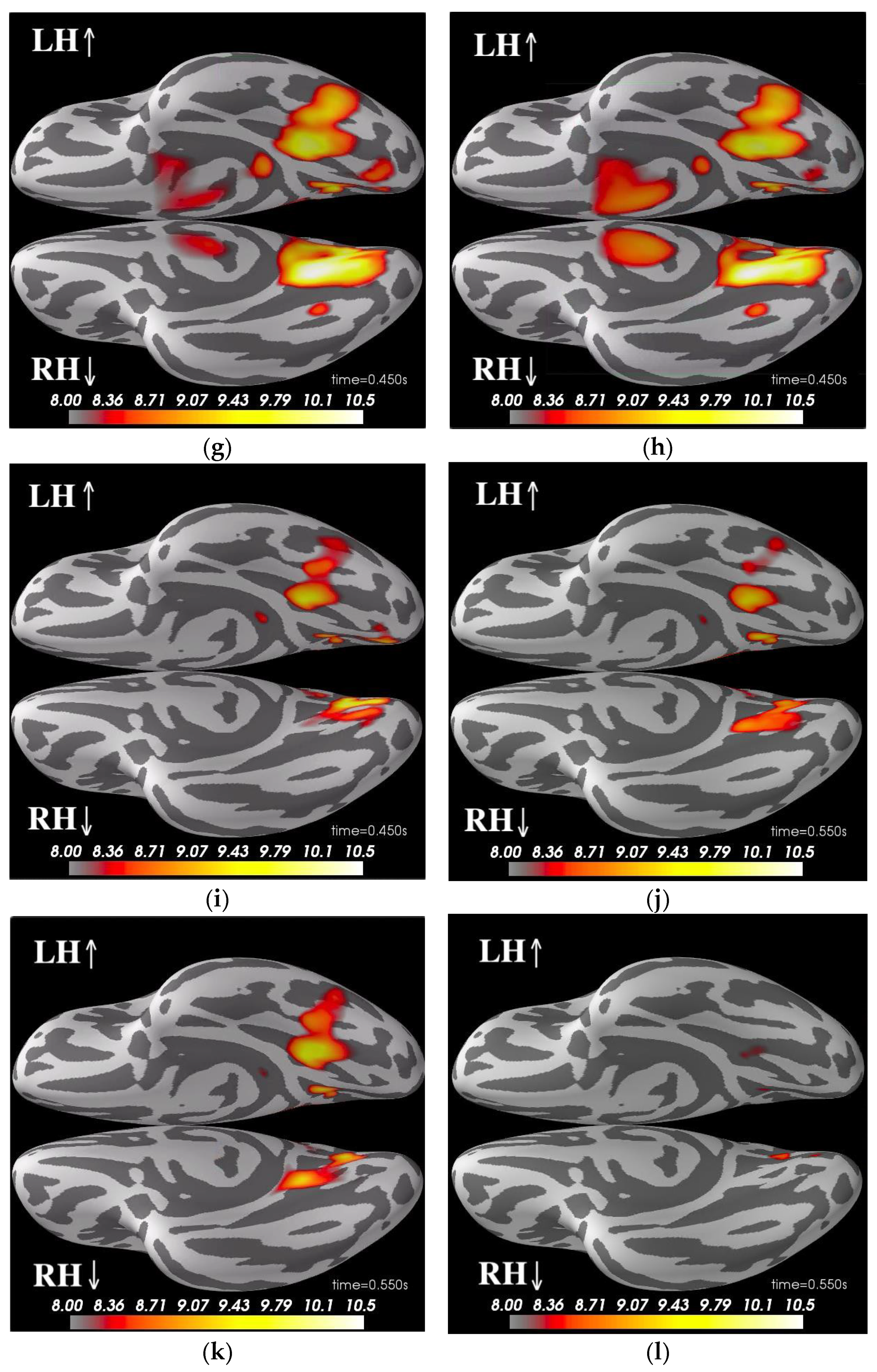
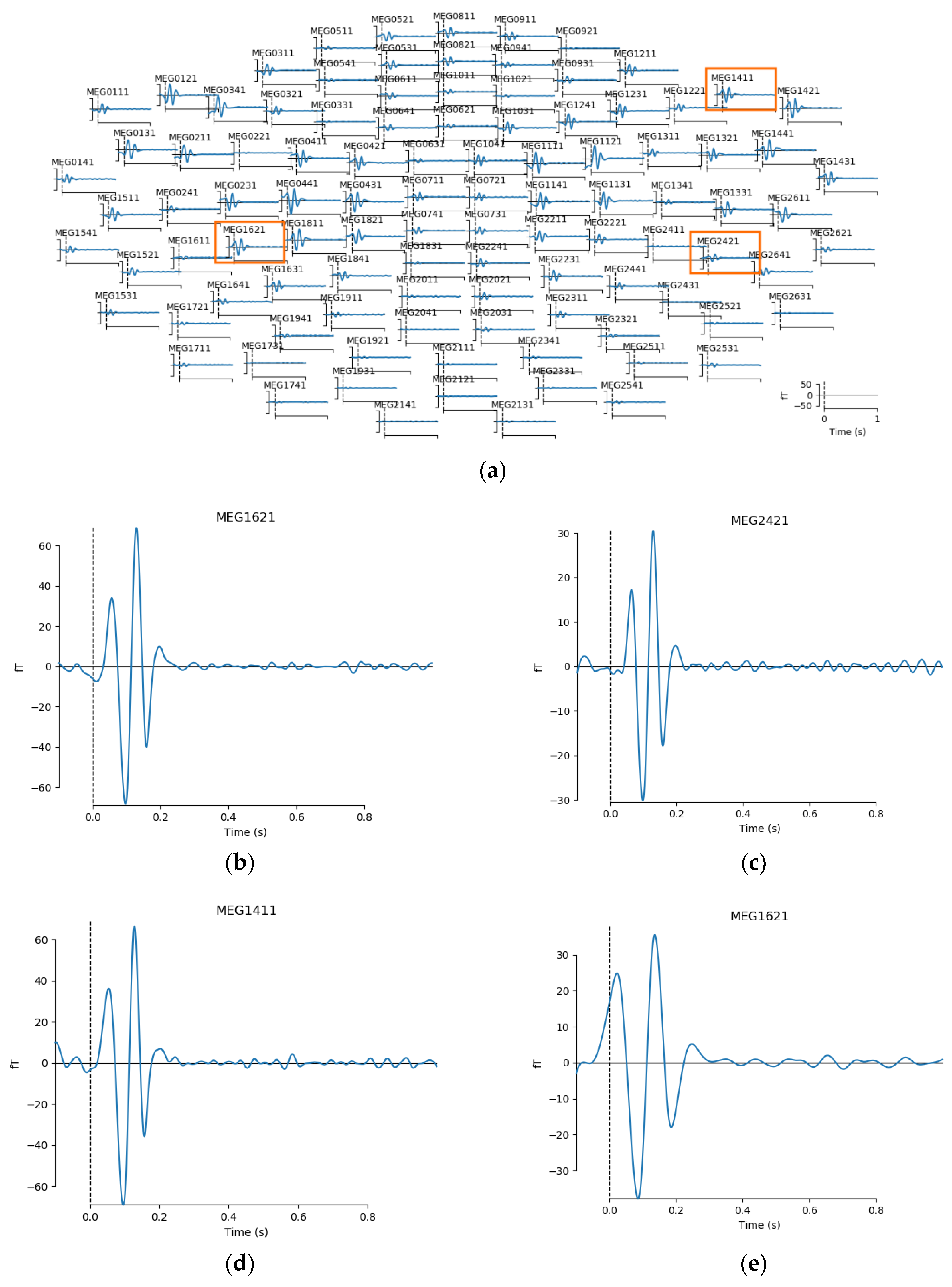
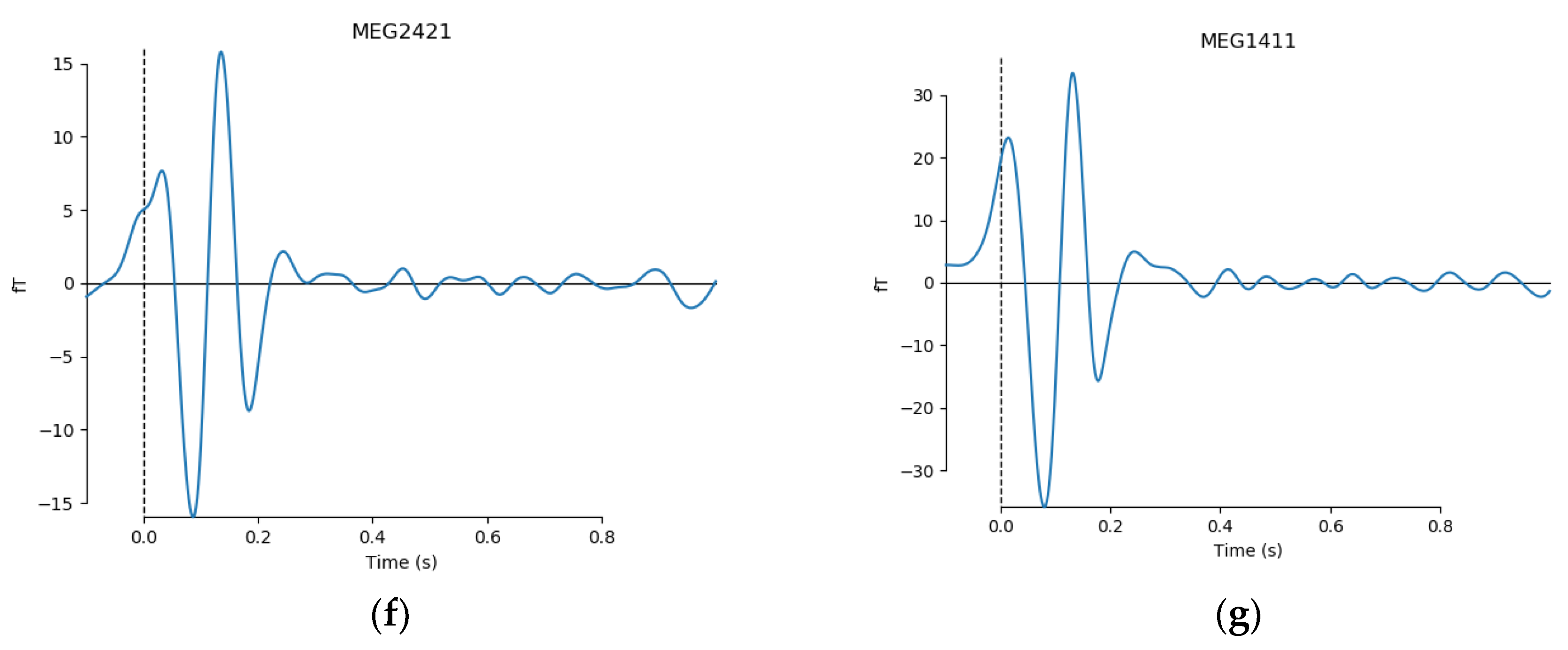

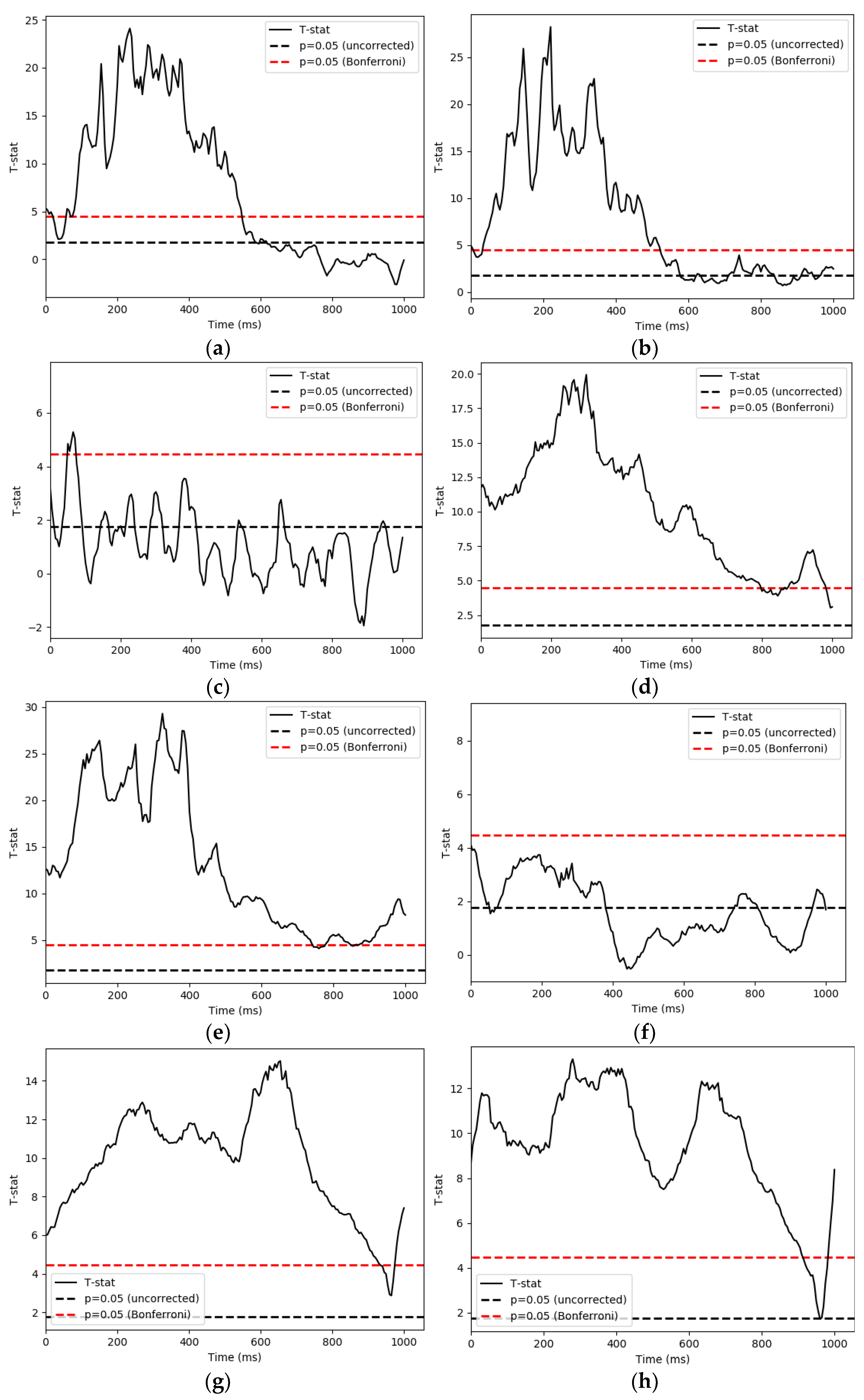

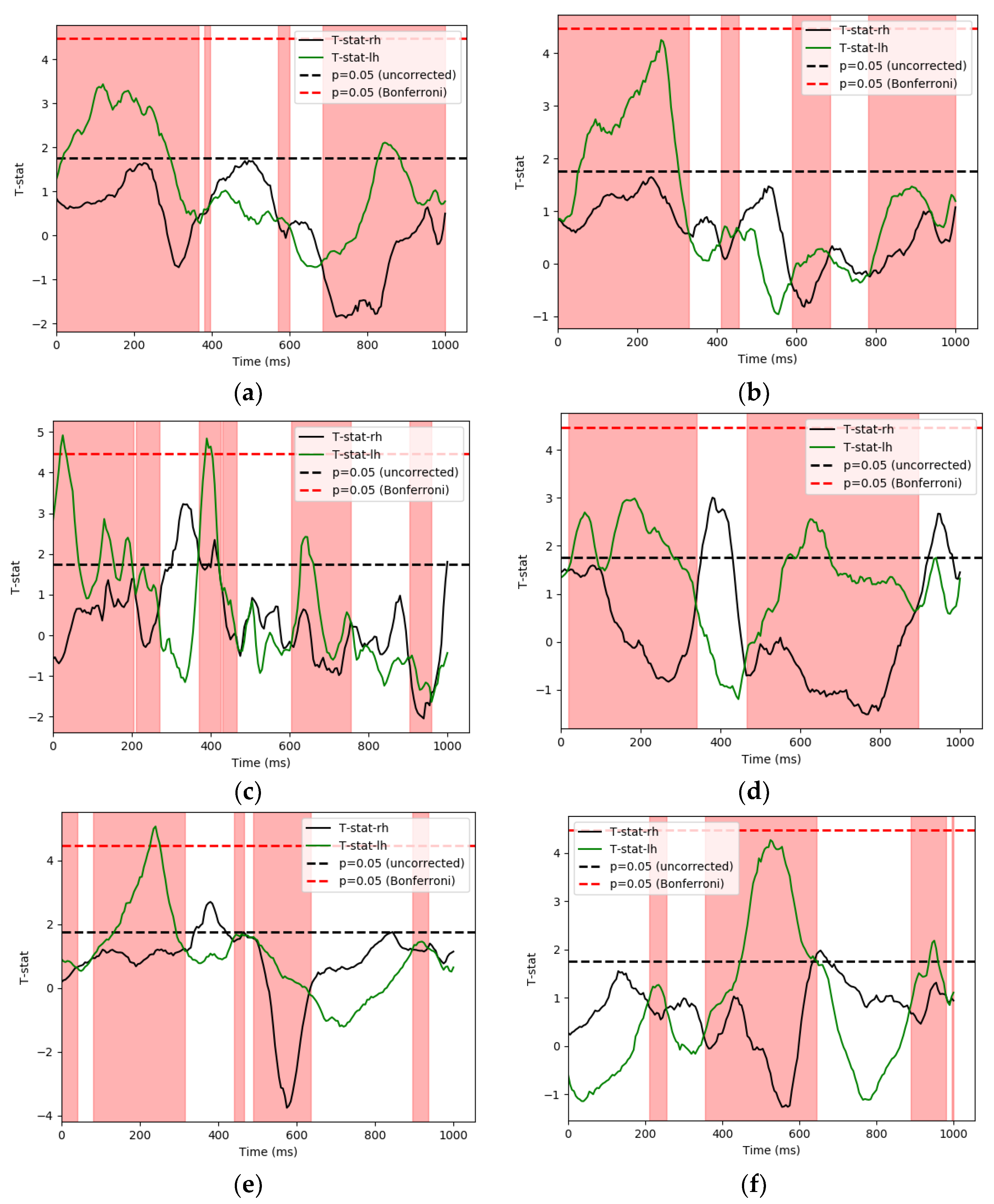
Publisher’s Note: MDPI stays neutral with regard to jurisdictional claims in published maps and institutional affiliations. |
© 2021 by the authors. Licensee MDPI, Basel, Switzerland. This article is an open access article distributed under the terms and conditions of the Creative Commons Attribution (CC BY) license (https://creativecommons.org/licenses/by/4.0/).
Share and Cite
Hsu, C.-H.; Wu, Y.-N. Application of Empirical Mode Decomposition for Decoding Perception of Faces Using Magnetoencephalography. Sensors 2021, 21, 6235. https://doi.org/10.3390/s21186235
Hsu C-H, Wu Y-N. Application of Empirical Mode Decomposition for Decoding Perception of Faces Using Magnetoencephalography. Sensors. 2021; 21(18):6235. https://doi.org/10.3390/s21186235
Chicago/Turabian StyleHsu, Chun-Hsien, and Ya-Ning Wu. 2021. "Application of Empirical Mode Decomposition for Decoding Perception of Faces Using Magnetoencephalography" Sensors 21, no. 18: 6235. https://doi.org/10.3390/s21186235
APA StyleHsu, C.-H., & Wu, Y.-N. (2021). Application of Empirical Mode Decomposition for Decoding Perception of Faces Using Magnetoencephalography. Sensors, 21(18), 6235. https://doi.org/10.3390/s21186235





